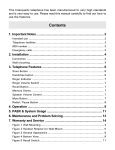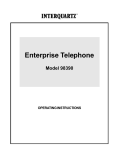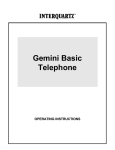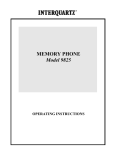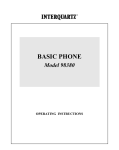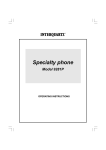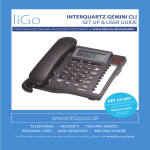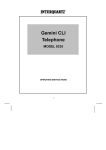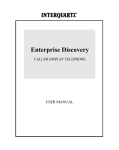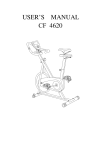Download Interquartz 98393B4 telephone
Transcript
Headset Speakerphone OPERATING INSTRUCTIONS 21 Contents 1. Important Notes ...................................................................... 2 Intended use ............................................................................................... 2 Telephone facilities ..................................................................................... 2 REN number ............................................................................................... 3 Emergency calls ......................................................................................... 4 2. Installation .............................................................................. 5 Connection ................................................................................................. 5 Wall mounting ............................................................................................. 5 3. Telephone Features ................................................................ 7 4. Operation .............................................................................. 11 5. PABX & System Usage ........................................................ 14 6. Maintenance and Problem Solving ..................................... 16 7. Warranty and Service ........................................................... 17 Figure 1 Wall Mounting ............................................................................. 5 Figure 2 Handset Retainer for Wall Mount ................................................ 6 Figure 3 General Appearance .................................................................. 7 Figure 4 Bottom View ............................................................................... 9 Figure 5 Recall Switch ............................................................................ 14 1 1. Important Notes Intended use This apparatus is intended for use on 2 wire analogue PSTN and PABX circuits within Europe. Declaration of Conformity Interquartz (UK) Limited declares under its sole responsibility that this product Model: Enterprise Headset Speakerphone Is in conformity with the following relevant harmonized standards Health & Safety Electromagnetic Compatibility 73/23/EEC EN55022 :1998 & EN55024 : 1998 Telecom TBR21 : 1998 & TBR38 : 1998 Following the provisions of Council Directive on radio equipment and telecommunications terminal equipment. January 2001 Telephone facilities This telephone has been designed for the use of the following facilities : manual or handsfree dialling headset port recall (earth or timed break switchable) MF signalling ringer indicator 2 ringer volume control ringer pitch adjust redial / pause mute function with LED indicator line powered triple standard message waiting (high voltage, reverse polarity + voltage drop) 20 memories accessed via 10 memory button (10 one touch and 10 two touch memories) EEprom lockable memories (EEprom memory selector underneath memory card) inductive loop hearing aid compatible desk or wall mountable (no bracket required) REN number The REN number of this telephone is 1. If you wish to connect any other equipment to the line, simply add the REN numbers of each piece together and ensure that the total does not exceed 4. If too many phones are connected to the line, the circuit may be overloaded and your telephone may not ring. Not all telephones have the same REN. If a British Telecom phone is supplied unmarked, you can assume that it has a REN of 1 3 Emergency calls Calls can be made on this telephone to contact the emergency services. An access code may also be required, if the phone is connected to a PABX. The European code for emergency services is 112, however, you can still use 999 in the UK. 4 2. Installation This telephone is designed to plug straight into a modular style socket. If you do not have one of these sockets, they can be obtained from your Network Supplier. Connection Insert the line cord into the socket. Set the ringer volume and pitch control as desired. Wall mounting Using the template supplied, position the telephone where you want to wall mount. Drill two holes and fix round headed screws, leaving them slightly proud of the surface. Position the telephone over the screws and slide downwards into place. FOR WALL MOUNT Figure 1 Wall Mounting 5 To enable the handset to be supported in the cradle when the phone is mounted on the wall, follow the procedure shown in Figure 2 to reserve the HANDSET RETAINER. 1.Use your thumb to press the HANDSET RETAINER 2. Push the HANDSET RETAINER out of the slot 3. Turn the HANDSET RETAINER 180. 4. Insert the HANDSET RETAINER back into it's slot Figure 2 Handset Retainer for Wall Mounting 6 3. Telephone Features EEPROM MEMORY SELECTOR (P, P+U, U) undernearth memory card RESET BUTTON (underneath memory card) HANDSET RINGER INDICATOR (message wait) HANDSET CORD MEMORY KEYS KEYPAD SPEAKER VOLUME CONTROL SWITCH STORE BUTTON HANDSFREE/ HEADSET BUTTON (with LED Indicator) MUTE BUTTON (with LED Indicator) RECALL BUTTON REDIAL / PAUSE BUTTON Figure 3 General Appearance To help you find your way round the telephone, various features and buttons are briefly described below. You should refer to the relevant section of this user guide to learn how to use the features available. Store Button Used to store numbers into the direct access memory buttons. 7 Handsfree / Headset button The function of this button is determined by the position of the HS/HF switch underneath the telephone (see section 4). With the switch set of HF (handsfree) then pressing this button switches the speakerphone mode on or off. The LED above the button glows when the speakerphone is on. With the switch set to HS (headset), then pressing this button transfers an incoming call directly to the headset. The red LED glows for the duration of the call which is terminated by pressing this button once more. 8 Ringer Indicator Flashes when the telephone rings with an incoming call or with a message waiting signal (See PABX section). Ringer Volume Switch Located on the base of the unit (see Figure 4). Move switch to select no sound (OFF), muted sound (LOW) or full sound (HIGH) for ringing on incoming call. Ringer Pitch Control On the base of the unit. Allows the pitch of the ringer to be altered from a high pitch to a low pitch. RINGER HI / LO / OFF SWITCH RINGER PITCH SWITCH HANDSFREE / HEADSET (HF/HS) SWITCH TIMED BREAK / EARTH RECALL (ER, TBR) SWITCH VOICE MESSAGING (N / S2 / S1) SWITCH Figure 4 Bottom View 9 Recall Button For PABX use, to carry out call transfers and access other PABX facilities. Memory Stores There are 10 buttons able to provide 20 memory locations (10 one touch and 10 two touch), each able to store 32 digits. Speaker Volume Control Allows the volume of the incoming caller to be adjusted, in handsfree operation. Simply move the slider switch to give a satisfactory voice level. Mute Button Pressing and releasing this button cuts off the handset so that the caller cannot hear your conversation. The red LED will light indicating that the mute is on. Pressing and releasing the button a second time will cancel the mute and return to normal conversation. If the telephone handset is replaced on the cradle with the mute on, the mute will automatically be released when the handset is next lifted. Redial / Pause Button When pressed as the first button - redials last number dialled Otherwise, it serves as a pause button inserting a 3.6 second pause in the number sequence. 10 4. Operation To dial a number, either lift the handset or press the handsfree button, wait for the tone and then key in the number required. Handsfree / Headset Mode The default setting is handsfree. If you do not intend to use the headset with this telephone then ignore this section. If you are using a headset, then you will need to change the operating mode of this telephone. Turn the unit over, locate the HS/HF switch (see figure 4) and move it to HS. Install your headset (the telephone has an RJ11 socket) and the telephone is ready for headset working. Pressing the headset button connects to line; a second press disconnects the line. The remainder of this manual assumes handsfree working but references to handsfree can be translated to headset. Answering a call You may answer a call by simply lifting the handset. If your telephone is set to handsfree mode (factory default) and you press the handsfree / headset button, the call will automatically be answered in full handsfree working. If you are using a headset (and your telephone is set to headset mode see above) then pressing the handsfree / headset button will automatically allow the call to be answered at the headset. 11 Manual Dialling Lift the handset, listen for the dial tone and then dial the required number using the keypad. Handsfree Dialling Press the handsfree button firmly and the dial tone will be heard in the speaker. Dial the required number on the keypad When the called party answers the phone, continue to speak using the microphone in the telephone or pick up the handset, if you so wish. With the handset in use it is possible to revert to speakerphone use by pressing the handsfree button BEFORE replacing the handset. Memory Storage / Dialling This telephone can store twenty memories behind ten one- and two-touch buttons. The numbers are stored in an eeprom which means that they will never be lost and batteries are not required for memory retention. To store numbers, ensure that the telephone is connected to the line either lift the handset or press the handsfree button press the store button dial the number to be stored using the keypad press the memory button where you want to save the number pressing the button just once stores the number in the top location pressing the number twice in quick succession, stores the number in the bottom location replace the handset or press the handsfree button to clear the line 12 To dial numbers from memory either lift the handset or press the handsfree button once dialling tone is present press the required memory button either ONCE to access the top location or TWICE IN QUICK SUCCESSION to access the bottom location. The required number will be sent to line. Memory Lock All memories programmed are stored on an eeprom inside the telephone and if required, can be locked to prevent them being overwritten. If you have problems overwriting memories it may be that the original ones have been locked in which case you will need to contact your Telecoms Manager Redial / Pause Function Redial If the number dialled is busy, obtain a new line - by replacing the telephone handset and then lifting it again. Press the button labelled redial/pause and the last number (up to 32 digits) that you dialled will automatically be redialled. 13 Pause The Pause command may be needed if the phone is connected to certain types of PABX or to any network where a pause is required. Note:No more that 3 pauses should be inserted consecutively otherwise the telephone may not function properly. Lift handset Dial any digits required before the pause Press Pause button Dial remaining digits Note: Reset button If the telephone appear not to function for any reason, pressing this button will re-set the telephone to Normal 14 5. PABX & System Usage This telephone can be used behind a PABX or on a network that utilises the recall function. There are many such systems and whilst it is likely that no problems will be encountered, it cannot be guaranteed that the telephone will operate correctly under all circumstances and any cases of difficulty should be referred to your supplier. Recall Before you attempt to change the recall switch, labelled TBR ER, see (Figure 4&5), you should disconnect the phone from the network. Figure 5 Recall Switch You will need a screwdriver, or similar tool to remove the cover plate over the switch. Simply slide the Switch marked ER TBR to the appropriate setting ( the factory default is TBR ). If you are unsure which setting is applicable, please consult your PABX manager or supplier. Do not adjust the switch marked N, S2, S1. Replace the cover, plug the phone back into the socket and it is ready for use. 15 PABX access Where a PABX access digit is required to obtain a direct outside line, it may be necessary to insert a pause after dialling the access digit (see redial / pause section of this manual ). Voice messaging When used behind a PABX, this telephone will respond to voice messaging systems on many PABX types, giving a visual signal of a message waiting. Your telephone manager will be aware of which system is relevant to your organisation and will adjust or advise you on the adjustment of your telephone accordingly. This adjustment is carried out by means of a switch, labelled N/S2/S1 , located next to the recall switch, mentioned above. As supplied, the telephone is set to the N (normal) position. Under no circumstances should this Voice messaging switch (Figure 4) be set at the S1 or S2 without the approval of your telecoms manager. In either of the S positions, the telephone must NOT be connected directly to a public network line. (Technical note : S1 and S2 are for reverse polarity messaging systems. With such a system in use, if the telephone does not respond in the S1 position, switch it to the S2 position and it should then respond. Some PABX’s require a certain level of software and/or hardware within the switch. If your telephone appears not to work, make sure that you have the correct software/hardware installed). 16 6. Maintenance and Problem Solving Your telephone is a precision electronic instrument. Avoid rough handling and extreme temperatures. Use a mild detergent and a damp cloth when cleaning. Never use a stronger cleaner. If your telephone does not appear to be working correctly, please check the following: No dialling tone Will not ring - Is phone cord properly connected to the wall socket? - ringer switch is set to off ? - REN number may exceed 4, for all telephones connected to the line. Disconnect a phone until the number is below 4. If there are still problems, and you have more than one telephone: Remove the problem phone. Insert another phone and check that it works. If yes then the problem phone is possibly faulty. If not, then you may have a faulty line. Try using the other socket and see which phones work. If you do have a faulty line then you should contact your Network Supplier. You should however be aware that if you request them to repair a fault that is found not to be theirs, then they are entitled to charge you for a visit. In the event that you still have problems then you should consult your supplier. 17 7. Warranty and Service This product is guaranteed, by Interquartz (UK) Limited, for six years from the date of manufacture. Every Interquartz telephone has a unique serial number and part of that number refers to the date of manufacture. A label, similar to that shown below is affixed to each telephone 0011 000852 (model no) The figure 0011 means that the telephone was made during week 11 (12 March) 2001. The six year warranty, cover will apply until 12 March 2007. A warranty is designed to cover either manufacturing faults or component defects. It is not designed to cover fair wear and tear. The Interquartz warranty is no exception. We look to you, our customer, to be reasonable and sensible over the warranty. We will endeavour to repair any telephone sent in to us within the warranty period but we reserve the right to charge for items that we consider replaceable under wear and tear. For example, if a handset cord splits within a few months, it will be replaced. If a phone is returned after, say, four years of heavy use with a similar problem, we might take a different view and wish to charge. If you have a genuine warranty problem and provided that the warranty seal has not been broken, we will either repair your telephone, or, at our sole discretion, replace it with a similar telephone. In the event that a model may have been discontinued, any replacement would have similar or better features. 18 If you need to return a faulty unit to us, send it to: Interquartz (UK) Limited Pennine House Salford Street Bury BL9 6YA Please ensure that you tell us what appears to be the problem with the telephone. DO NOT FORGET TO INCLUDE YOUR OWN NAME AND ADDRESS. We ask that you bear the cost of returning the telephone to us. We will return it to you, at our expense. This warranty is in addition to any statutory rights. For further advice visit our Website www.interquartz.co.uk 19 This telephone is approved to EEC directive 1999/5/EC Distributed in the United Kingdom by Interquartz (UK) Limited Manufactured by International Quartz Limited 3C9393012S12B A Subsidiary of Chiaphua Industries Ltd. ©Copyright INTERNATIONAL QUARTZ LTD. 2002 20





















